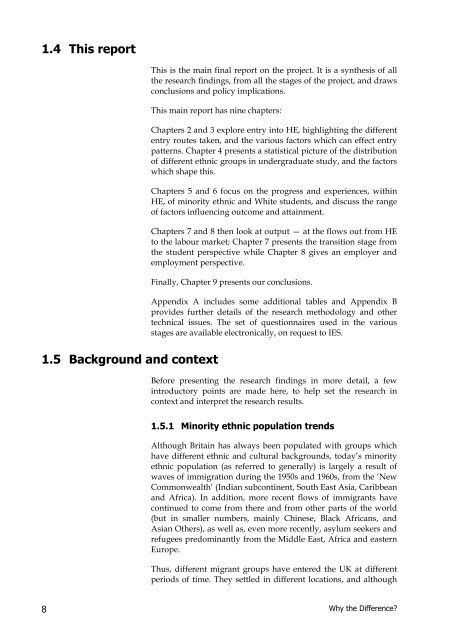A Closer Look at Higher Education Minority Ethnic Students and ...
A Closer Look at Higher Education Minority Ethnic Students and ...
A Closer Look at Higher Education Minority Ethnic Students and ...
You also want an ePaper? Increase the reach of your titles
YUMPU automatically turns print PDFs into web optimized ePapers that Google loves.
1.4 This reportThis is the main final report on the project. It is a synthesis of allthe research findings, from all the stages of the project, <strong>and</strong> drawsconclusions <strong>and</strong> policy implic<strong>at</strong>ions.This main report has nine chapters:Chapters 2 <strong>and</strong> 3 explore entry into HE, highlighting the differententry routes taken, <strong>and</strong> the various factors which can effect entryp<strong>at</strong>terns. Chapter 4 presents a st<strong>at</strong>istical picture of the distributionof different ethnic groups in undergradu<strong>at</strong>e study, <strong>and</strong> the factorswhich shape this.Chapters 5 <strong>and</strong> 6 focus on the progress <strong>and</strong> experiences, withinHE, of minority ethnic <strong>and</strong> White students, <strong>and</strong> discuss the rangeof factors influencing outcome <strong>and</strong> <strong>at</strong>tainment.Chapters 7 <strong>and</strong> 8 then look <strong>at</strong> output — <strong>at</strong> the flows out from HEto the labour market; Chapter 7 presents the transition stage fromthe student perspective while Chapter 8 gives an employer <strong>and</strong>employment perspective.Finally, Chapter 9 presents our conclusions.Appendix A includes some additional tables <strong>and</strong> Appendix Bprovides further details of the research methodology <strong>and</strong> othertechnical issues. The set of questionnaires used in the variousstages are available electronically, on request to IES.1.5 Background <strong>and</strong> contextBefore presenting the research findings in more detail, a fewintroductory points are made here, to help set the research incontext <strong>and</strong> interpret the research results.1.5.1 <strong>Minority</strong> ethnic popul<strong>at</strong>ion trendsAlthough Britain has always been popul<strong>at</strong>ed with groups whichhave different ethnic <strong>and</strong> cultural backgrounds, today’s minorityethnic popul<strong>at</strong>ion (as referred to generally) is largely a result ofwaves of immigr<strong>at</strong>ion during the 1950s <strong>and</strong> 1960s, from the ‘NewCommonwealth’ (Indian subcontinent, South East Asia, Caribbean<strong>and</strong> Africa). In addition, more recent flows of immigrants havecontinued to come from there <strong>and</strong> from other parts of the world(but in smaller numbers, mainly Chinese, Black Africans, <strong>and</strong>Asian Others), as well as, even more recently, asylum seekers <strong>and</strong>refugees predominantly from the Middle East, Africa <strong>and</strong> easternEurope.Thus, different migrant groups have entered the UK <strong>at</strong> differentperiods of time. They settled in different loc<strong>at</strong>ions, <strong>and</strong> although8Why the Difference?
















